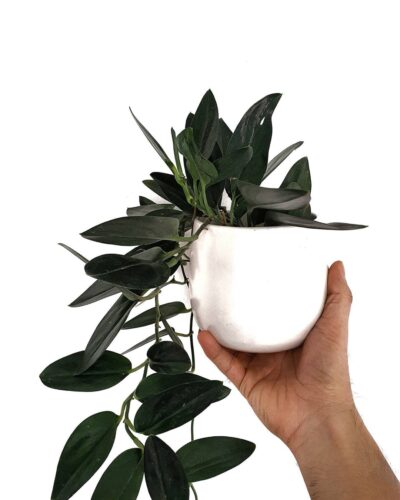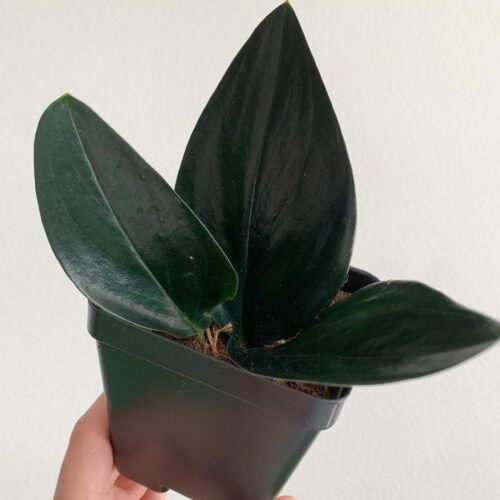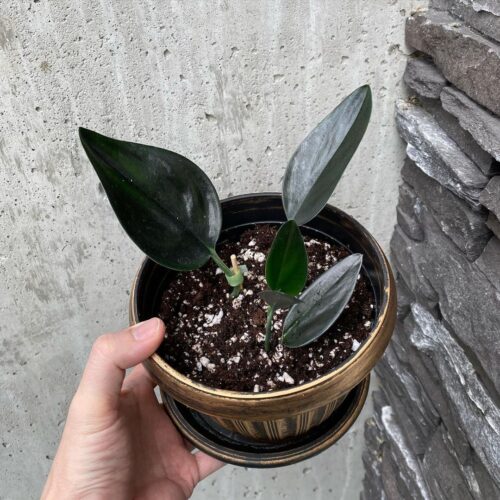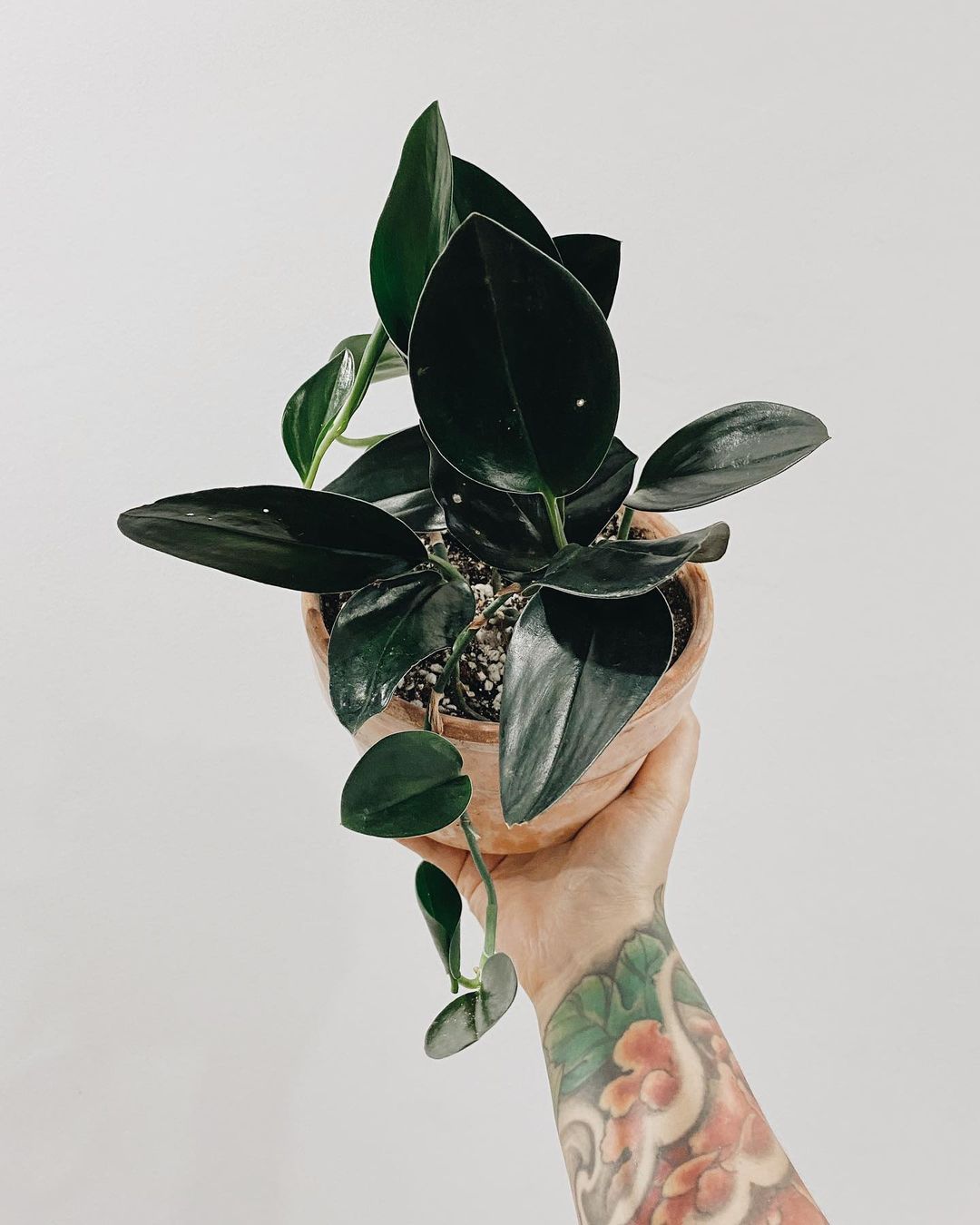Look at this Black Pothos: Scindapsus treubii ‘Dark Form’ Growing Guide that covers everything related to caring for this plant.
Check this Black Pothos: Scindapsus treubii ‘Dark Form ’Growing Guide for expert tips and tricks for nurturing this beautiful specimen in your home.
Common Names: Scindapsus nearly black, Scindapsus treubii black, Scindapsus treubii dark
Botanical Name: Scindapsus treubii ‘Dark Form’
USDA Zones: 10b or above
LEARN Growing and Propagating Pothos in Water
What is Black Pothos?

Scindapsus treubii Dark Form is a type of Scindapsus treubii plant, also popular as Black Pothos. It’s famous for its soft, dark green to black leaves that look really unique and interesting. This plant comes from Southeast Asia. There are different types of Scindapsus treubii plants, but the Dark Form is special because it looks striking and is easy to care for.
Family and Native Place: Araceae
Appearance: Black Pothos is a trailing plant with lance-shaped leaves. The leaves are dark green to black in color, with a shiny and waxy texture. The plant grows as a vine, producing long stems that can hang down or climb if given support.
Growth Rate: Black pothos has a Moderate growth rate.
Height and Spread: Black pothos can grow up to 6 to 8 feet long and 1-3 feet wide.
Flowers: Black Pothos can produce small, inconspicuous flowers, but they are rarely seen when grown as a houseplant.
Stems: Scindapsus treubii has thin, almost black stems and feels smooth to the touch. The leaves come out one after the other in a pattern, and on the other side of the leaves, you can see roots hanging in the air. When a new branch grows, it starts from the angle between the stem and leaves.
Foliage: The foliage is the main attraction of the Black pothos plant. The leaves are deep green to almost black, creating a striking contrast with other houseplants. The leaves have a somewhat velvet-like appearance.
Do Pothos Like Humidity? FIND THE ANSWER
How to Propagate Scindapsus treubii Dark Form

Propagation methods for Scindapsus treubii Dark Form include:
- Stem Cuttings
- Air Layering
- Division
The easiest method among these is Stem Cuttings:
This method involves taking a healthy stem cutting from the existing Black Pothos plant and encouraging it to develop roots in a suitable growing medium.
- Choose a healthy stem from your Black Pothos with at least a few leaves. Cut the stem just below a node using a sharp, clean pair of scissors or pruning shears.
- Remove the lower leaves from the stem, leaving a few at the top. This will prevent excessive moisture loss during the rooting process.
- Let the cut end of the stem dry for a few hours or overnight. This helps to prevent rot when the cutting is placed in soil.
- Fill a small pot with a well-draining potting mix.
- Insert the cut end of the stem into the soil, burying at least one node’s length under the soil. Gently press the soil around the cutting to secure it.
- To create a humid environment for the cutting, you can place a clear plastic bag or a plastic dome over the pot. This helps to retain moisture and encourage root development.
- Keep the pot in a location with bright, indirect light. Avoid direct sunlight, as it can scorch the cutting.
- Water the Black pothos cutting when the top inch of the soil feels dry. Avoid overwatering, as this can lead to root rot. Mist the cutting occasionally to maintain humidity.
- After a few weeks, gently tug on the cutting to feel for resistance. If you feel resistance, it means that roots have started to form.
- Once the Black pothos cutting has developed a sufficient root system, you can transplant it into a slightly larger pot with regular potting soil.
Learn How to Care and Propagate Baltic Blue Pothos
Best Pot for Black Pothos
For growing Black Pothos indoors, choose a 4-6 inch pot for initial potting. Repot as needed, moving up one pot size. Ensure the pot has drainage holes to prevent waterlogging. Repot every 1-2 years to promote healthy growth.
Scindapsus Treubii Moonlight vs. Dark Form
Scindapsus Moonlight boasts graceful oval leaves with a silvery glow, while the Dark Form features rich green foliage that can take on a blackish hue under specific lighting conditions.
READ Philodendron Orange Marmalade Care Guide
Ideal Growing Conditions for Black Pothos

Sunlight
Black Pothos thrives in moderate to bright indirect light. Intense, direct sunlight should be avoided as it can lead to leaf scorching. Filtered or dappled sunlight best maintains the lush foliage in Black pothos.
Ideal placement includes areas with abundant indirect light, such as north or east-facing windows. If exposure to direct sunlight is certain, use a sheer curtain or position the plant a few feet away from the window to safeguard the leaves from harm.
Soil
For healthy Scindapsus treubii Dark Form, use a well-draining potting mix. Blend potting soil with perlite or orchid bark in equal parts to enhance aeration and drainage. Aim for a slightly acidic to neutral pH level, ideally between 6.0 to 7.0. This mix prevents waterlogging and promotes vibrant growth of Black pothos, which is crucial for the plant’s well-being.
Water
Scindapsus treubii Dark Form, also known as black pothos, thrives with moderate watering. Allow the top inch of soil to dry before watering, usually every 1-2 weeks in warmer months and less often during winter. Water thoroughly until it drains from the bottom, avoiding standing water. Overwatering can lead to root rot, so ensure proper drainage.
Temperature
Black pothos prefers temperatures between 65-80°F (18-27°C). It thrives in USDA Zones 10-12, generally encompassing regions with mild to warm climates. Protect it from drafts and extreme temperature fluctuations. Avoid cold snaps below 50°F (10°C) and ensure adequate humidity, especially in cooler environments.
CHECK Tillandsia Magnusiana Care and Display Ideas
Black Pothos Care

Fertilizer
Black pothos benefit from balanced liquid fertilizers like a 10-10-10 or 20-20-20 NPK ratio. During the growing season (spring and summer), fertilize every 4-6 weeks to support growth. Reduce feeding frequency to every 6-8 weeks during dormancy (fall and winter). Dilute fertilizer to half or quarter strength to prevent overfeeding, which can harm the plant. Always water before fertilizing and avoid applying fertilizer to dry soil.
Pruning
Pruning black pothos helps maintain its shape and encourages new growth. Trim back overgrown or leggy vines just above a leaf node. This stimulates branching. Prune damaged or yellowing leaves at their base.
Spring or early summer is the best time to prune, as the plant is entering its active growth phase. Regular pruning keeps the plant lush and attractive. Disinfect tools before use to prevent disease spread.
Pests and Diseases
Like other houseplants, black pothos can be susceptible to pests and diseases. Some common issues to watch out for include:
Pests:
- Mealybugs: These small, white, cotton-like insects can cluster on the undersides of leaves and along stems. They suck sap, leading to stunted growth and yellowing leaves.
- Spider Mites: These tiny insects can cause stippled leaves and webbing on the plant. They thrive in dry conditions.
- Scale Insects: These pests appear as small, raised bumps on stems and leaves. They feed on plant juices and can weaken the plant.
- Aphids: Small insects that can cause distorted growth and yellowing by feeding on plant sap.
Diseases:
- Root Rot: Overwatering or poor drainage can lead to root rot caused by fungi that attack the black pothos roots. Yellowing, wilting, and leaf drop may occur.
- Leaf Spot: Fungal or bacterial infections can cause brown or black spots on leaves. Remove affected leaves and improve air circulation.
- Powdery Mildew: A white powdery substance on leaves indicates this fungal disease. It thrives in humid conditions.
- Bacterial Leaf Blight: Characterized by water-soaked spots on leaves that turn brown and spread. Maintain good hygiene and avoid overhead watering.
Prevention of Pests and Diseases in Scindapsus treubii Dark Form:
Regularly inspect black pothos, isolate new additions, and maintain good air circulation while avoiding overcrowding. Water at the base to keep leaves dry, deterring fungal growth. Swiftly quarantine and address any issues, considering natural remedies like neem oil for minor infestations. Reserve chemical treatments for severe cases, using them cautiously.
Check Hoya Imperialis Care Guide
Scindapsus treubii Dark Form – FAQs

Q.1: Is Scindapsus treubii Dark Form toxic to pets?
A: Yes, Black Pothos is toxic if ingested by pets due to calcium oxalate crystals. Keep it out of their reach.
Q.2: What should I do if my Black Pothos leaves turn yellow?
A: Yellow leaves could be due to overwatering, poor drainage, or inadequate light. Adjust watering habits and consider changing its position to improve conditions.
Q.3: Why are my Black Pothos leaves losing their color?
A: Loss of color could indicate insufficient light. Move the plant to a brighter location to help retain its dark foliage.
Q:4: When is the best time to repot Black Pothos?
A: Repot Black Pothos when it becomes root-bound or outgrows its container. Spring is generally a good time.
Q:5: Can I use chemical pesticides on my Black Pothos?
A: Chemical pesticides should be a last resort. Try natural remedies on Black Pothos first and ensure proper ventilation when using chemicals.
Q4: How do I start propagating Black Pothos in water?
- Choose a healthy stem cutting with at least one node. Ensure the cutting is about 4-6 inches in length.
- Use clean, sharp scissors or pruning shears to trim the cutting just below a node. This is where the new roots will emerge.
- Place the cutting in a jar or vase of water, making sure the node is submerged while the leaves are above the waterline.
- Put the container in a spot with indirect sunlight. Avoid direct sunlight, as it can cause the cutting to overheat or the water to become too warm.
Q5: How do I care for the propagating Black Pothos in water?
- Use room-temperature, non-chlorinated water. Change the water every 1-2 weeks to prevent stagnation and ensure the cutting has access to nutrients.
- Provide indirect light. Too much direct sunlight can stress the cutting.
- Maintain a consistent room temperature between 65-75°F (18-24°C).



